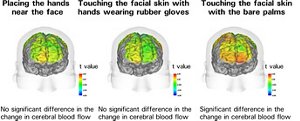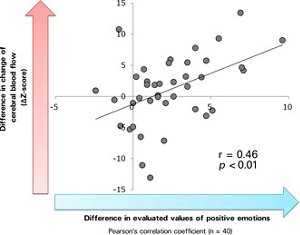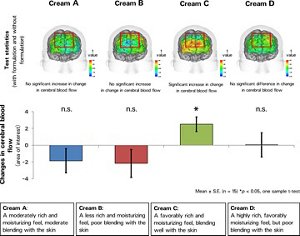Research on Skin Care Linked to Emotions
Confirmation of Relationship between 'Comfort' from Touching the Skin during Skin Care and the Change in Cerebral Blood Flow
This is an English translation of the news release in Japanese on October 12th.
Kansei Science Research, Skincare Products Research, and Makeup Products Research laboratories of Kao Corporation (Michitaka Sawada, President) have obtained the following research findings during ongoing skin care research focusing on stimulation that generates positive emotions.
1) Tactile stimulation by touching the facial skin with the palm of the hands causes an increase in blood flow in the brain's prefrontal area*1 of the cerebral cortex compared to the state of rest (Fig. 1).
2) The findings indicate that the greater the change in blood flow in the prefrontal area caused by tactile stimulation by the palms to the face the greater degree of positive emotions evoked (Fig. 2).
3) When cream is applied to the inside of the forearm, as one of the skin care activities, the change in blood flow in the brain's prefrontal area varies according to how application is sensed (Fig. 3).
Part of the research content was presented at the 20th Annual Meeting of Japan Society of Kansei Engineering (Tokyo, September 4 to 6, 2018).
-
* 1 prefrontal area:
The prefrontal area here refers to orbitofrontal cortex (OFC) and frontal pole cortex (FPC) of the brain. The area is known to play a role in the reward system (the nervous system responsible for pleasant emotions and recognition).
Past research findings from the Research on Skin Care Linked to Emotions
- Twelve factors to evaluate emotions while applying cosmetics were extracted and an emotional assessment scale was created.
- Tactile stimulation on the facial skin included in skin care behavior arouses positive emotions.
- Continuous tactile stimulation on the facial skin, evokes positive emotions and enhances the visual skin condition (skin appearance).
- The relationship between the amount of oxytocin in saliva and skin appearance was confirmed.
Recent research findings
Kao examined the effects of touching the facial skin with the palms on cerebral blood flow under the following testing conditions.
Study 1
Subjects: 20 women aged 20-49
Method:
A change in cerebral blood flow in the prefrontal area of the brain was measured using near-infrared spectroscopy (NIRS)*2 under three conditions: one in which bare hands touched the facial skin and two other control conditions (touching facial skin with hands wearing rubber gloves and only placing the hands near the face). Then the association between the change in blood flow and the degree to which positive emotions were aroused was analyzed.
Participants touched their facial skin with their palms for 15 seconds alternating with a rest time of 20 seconds in a cycle repeated six times. The standard score (Z-score) of the difference in cerebral blood flow during facial skin touch by the palms compared to the resting state was calculated.
-
* 2 Near-infrared spectroscopy (NIRS)
NIRS stands for near-infrared spectroscopy which is the methodology for determining brain activities based on changes in hemoglobin concentration. NIRS has the advantage of being able to measure movement relatively similar to that in daily life.
The degree of positive emotion evoked was expressed as the evaluated value of positive emotions by measuring the degree of sensation of positive emotions with the use of a 10-cm visual analog scale.
Results:
Results showed that touch of the facial skin with the bare palms significantly increased the change in blood flow in the prefrontal area to a degree higher of that in a resting state (Fig. 1). Moreover, a moderate positive correlation was observed between the difference in blood flow change in the prefrontal area under the condition of facial skin touch with the bare palms as well as the other control conditions, and in the difference in the evaluated values of positive emotions (Fig. 2).

Fig. 1: Changes in cerebral blood flow in the prefrontal area on touching facial skin with the palms
The colored parts in the brain image show the varied probabilities of difference in blood flow from a resting state. The more reddish areas indicate a higher probability of the region being more active.

Fig. 2: The relation between change in cerebral blood flow in the prefrontal area and the level of positive emotion aroused
Study 2
Subjects:
15 women aged 20-49 years
Method:
As an example of skin care activity, participants applied four types of cream with different application sensations (Creams A, B, C, and D) to the inside of the forearm. Changes in cerebral blood flow on application were measured by NIRS.
Participants experienced stimulation by applying cream for 20 seconds alternating with a rest time of 20 seconds in a cycle repeated four times. The areas showing a positive correlation with a level of positive emotion arousal in Study 1 were used as areas of interest (the areas marked by a red frame in Fig. 3). The standard score (Z-score) was calculated for the difference between cerebral blood flow changes in cream application and resting.
Results
In the skin care activity of applying cream to the forearm, it was confirmed that the change in blood flow in the area of interest varied depending on the sensation during application (Fig. 3). Cream C, with a significant difference in cerebral blood flow change, had a rich, moisturizing feel and blended with the skin favorably.

Fig. 3: Comparison of the change in blood flow in the prefrontal area upon application of four types of cream
Conclusion:
Research results suggest that activity in the prefrontal area of the brain increased in response to the level of positive emotions aroused by facial skin touch with the palms and cream application.
About Kao
Kao creates high-value-added products that enrich the lives of consumers around the world. Through its portfolio of over 20 leading brands such as Attack, Bioré, Goldwell, Jergens, John Frieda, Kanebo, Laurier, Merries and Molton Brown, Kao is part of the everyday lives of people in Asia, Oceania, North America and Europe. Combined with its chemical division, which contributes to a wide range of industries, Kao generates about 1,500 billion yen in annual sales. Kao employs about 33,000 people worldwide and has 130 years of history in innovation. Please visit the Kao Group website for updated information.
Media inquiries should be directed to:
Corporate Communications
Kao Corporation
